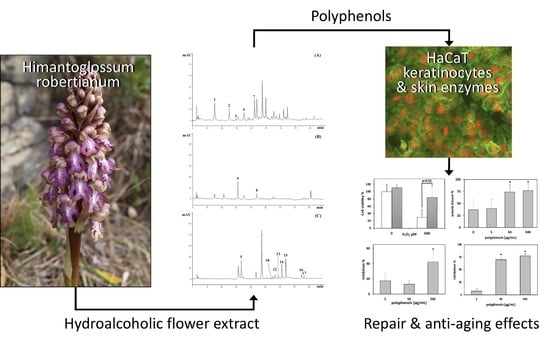Polyphenol Characterization and Skin-Preserving Properties of Hydroalcoholic Flower Extract from Himantoglossum robertianum (Orchidaceae)
Abstract
1. Introduction
2. Results
2.1. Flower Morphological Characterization
2.2. Phytochemical Characterization
2.3. Antioxidant and Free-Radical Scavenging Activity
2.4. Effects of HFE on Keratinocytes and Skin Enzymes
3. Discussion
4. Materials and Methods
4.1. Plant Materials
4.2. Reagents and Cells
4.3. Light and Scanning Electron Microscopy Analyses
4.4. Hydroalcoholic Flower Extract (HFE) Preparation
4.5. Chemical Characterization
4.5.1. Total Phenols
4.5.2. Flavonoids
4.5.3. Vanillin Index
4.5.4. Proanthocyanindin and Anthocyanin Content
4.5.5. Polyphenol Profile by Reversed Phase Liquid Chromatography with Diode Array Detection (RP-LC-DAD)
4.6. Antioxidant and Free-Radical Scavenging Activities
4.6.1. Scavenging Activity of 2,2-diphenyl-1-picrylhydrazyl (DPPH) Free Radical
4.6.2. Trolox Equivalent Antioxidant Capacity (TEAC)
4.6.3. Ferric-Reducing Antioxidant Potential (FRAP)
4.6.4. Oxygen Radical Absorbance Capacity (ORAC)
4.6.5. β-Carotene Bleaching Assay
4.6.6. Iron-Chelating Activity
4.7. Biological Assays
4.7.1. Collagenase and Elastase Inhibition Assays
4.7.2. Cytotoxicity and Cytoprotection Assays
4.7.3. In Vitro Wound Healing Assay
4.8. Statistical Analysis
Author Contributions
Funding
Conflicts of Interest
References
- Hossain, M.M. Therapeutic orchids: Traditional uses and recent advances—An overview. Fitoterapia 2011, 82, 102–140. [Google Scholar] [CrossRef] [PubMed]
- Mustafa, B.; Hajdari, A.; Pieroni, A.; Pulaj, B.; Koro, X.; Quave, C.L. A cross-cultural comparison of folk plant uses among Albanians, Bosniaks, Gorani and Turks living in south Kosovo. J. Ethnobiol. Ethnomed. 2015, 11, 39. [Google Scholar] [CrossRef] [PubMed]
- Chinsamy, M.; Finnie, J.F.; Van Staden, J. Anti-inflammatory, antioxidant, anti-cholinesterase activity and mutagenicity of South African medicinal orchids. S. Afr. J. Bot. 2014, 91, 88–98. [Google Scholar] [CrossRef]
- Schuster, R.; Zeindl, L.; Holzer, W.; Khumpirapang, N.; Okonogi, S.; Viernstein, H.; Mueller, M. Eulophia macrobulbon—An orchid with significant anti-inflammatory and antioxidant effect and anticancerogenic potential exerted by its root extract. Phytomedicine 2017, 24, 157–165. [Google Scholar] [CrossRef]
- Sut, S.; Maggi, F.; Dall’Acqua, S. Bioactive Secondary Metabolites from Orchids (Orchidaceae). Chem. Biodivers. 2017, 14, e1700172. [Google Scholar] [CrossRef]
- Tadokoro, T.; Bonte, F.; Archambault, J.C.; Cauchard, J.H.; Neveu, M.; Ozawa, K.; Noguchi, F.; Ikeda, A.; Nagamatsu, M.; Shinn, S. Whitening efficacy of plant extracts including orchid extracts on Japanese female skin with melasma and lentigo senilis. J. Dermatol. 2010, 37, 522–530. [Google Scholar] [CrossRef]
- Hadi, H.; Razali, S.N.; Awadh, A.I. A Comprehensive Review of the Cosmeceutical Benefits of Vanda Species (Orchidaceae). Nat. Prod. Commun. 2015, 10, 1483–1488. [Google Scholar] [CrossRef]
- Nguyen, H.C.; Lin, K.H.; Huang, M.Y.; Yang, C.M.; Shih, T.H.; Hsiung, T.C.; Lin, Y.C.; Tsao, F.C. Antioxidant Activities of the Methanol Extracts of Various Parts of Phalaenopsis Orchids with White, Yellow, and Purple Flowers. Not. Bot. Horti Agrobot. 2018, 46, 457–465. [Google Scholar] [CrossRef]
- Giri, L.; Belwal, T.; Bahukhandi, A.; Suyal, R.; Bhatt, I.D.; Rawal, R.S.; Nandi, S.K. Oxidative DNA damage protective activity and antioxidant potential of Ashtvarga species growing in the Indian Himalayan Region. Ind. Crops Prod. 2017, 102, 173–179. [Google Scholar] [CrossRef]
- Pagani, F. Plant constituents of Orchidaceae. I. Components of Orchis sambucina L., Orchis morio L. Boll. Chim. Farm. 1976, 115, 407–412. [Google Scholar]
- Strack, D.; Busch, E.; Klein, E. Anthocyanin patterns in European orchids and their taxonomic and phylogenetic relevance. Phytochemistry 1989, 28, 2127–2139. [Google Scholar] [CrossRef]
- Sgarbi, E.; Ranieri, R.; Santunione, G. Effect of Temporary Immersion System on in vitro development of Himantoglossum robertianum (Loisel.) P. Delforge (Orchidaceae). In Proceedings of the 114° Congresso della Società Botanica Italiana (S.B.I.)—VI International Plant Science Conference, Padova, Italy, 4–7 September 2019; p. 12. [Google Scholar]
- Bournérias, M.; Prat, D. Les Orchidées de France, Belgique et Luxembourg, 2nd ed.; Biotope Éditions: Mèze, France, 2005. [Google Scholar]
- Gutiérrez, I.R.; Labarga, J.M.M.; Díaz, J.A.; Fernández de Castro, A.G.; Saiz, J.C.M. Expansion of Himantoglossum robertianum (Orchidaceae) in Madrid: A case study on environmental variables and geographical distribution. Mediterr. Bot. 2018, 39, 111–117. [Google Scholar] [CrossRef]
- Ertuğ, F. Wild edible plants of the Bodrum area (Mugla, Turkey). Turk. J. Bot. 2004, 28, 161–174. [Google Scholar]
- Lentini, F.; Venza, F. Wild food plants of popular use in Sicily. J. Ethnobiol. Ethnomed. 2007, 3, 15. [Google Scholar] [CrossRef]
- Ghorbani, A.; Gravendeel, B.; Naghibi, F.; de Boer, H. Wild orchid tuber collection in Iran: A wake-up call for conservation. Biodivers. Conserv. 2014, 23, 2749–2760. [Google Scholar] [CrossRef]
- Gallego, E.; Gelabert, A.; Roca, F.; Perales, J.F.; Guardino, X. Identification of volatile organic compounds (VOC) emitted from three European orchid species with different pollination strategies: Two deceptive orchids (Himantoglossum robertianum and Ophrys apifera) and a rewarding orchid (Gymnadenia conopsea). J. Biodivers. Environ. Sci. 2012, 2, 18–29. [Google Scholar]
- Smeriglio, A.; Cornara, L.; Denaro, M.; Barreca, D.; Burlando, B.; Xiao, J.; Trombetta, D. Antioxidant and cytoprotective activities of an ancient Mediterranean citrus (Citrus lumia Risso) albedo extract: Microscopic observations and polyphenol characterization. Food Chem. 2019, 279, 347–355. [Google Scholar] [CrossRef]
- Thuong, P.T.; Hung, T.M.; Ngoc, T.M.; Ha do, T.; Min, B.S.; Kwack, S.J.; Kang, T.S.; Choi, J.S.; Bae, K. Antioxidant activities of coumarins from Korean medicinal plants and their structure-activity relationships. Phytother. Res. 2010, 24, 101–106. [Google Scholar] [CrossRef]
- Ranzato, E.; Magnelli, V.; Martinotti, S.; Waheed, Z.; Cain, S.M.; Snutch, T.P.; Marchetti, C.; Burlando, B. Epigallocatechin-3-gallate elicits Ca2+ spike in MCF-7 breast cancer cells: Essential role of Cav3.2 channels. Cell Calcium 2014, 56, 285–295. [Google Scholar] [CrossRef]
- Elbling, L.; Weiss, R.M.; Teufelhofer, O.; Uhl, M.; Knasmueller, S.; Schulte-Hermann, R.; Berger, W.; Micksche, M. Green tea extract and (−)-epigallocatechin-3-gallate, the major tea catechin, exert oxidant but lack antioxidant activities. FASEB J. 2005, 19, 807–809. [Google Scholar] [CrossRef]
- Thring, T.S.; Hili, P.; Naughton, D.P. Anti-collagenase, anti-elastase and anti-oxidant activities of extracts from 21 plants. BMC Complement. Altern. Med. 2009, 9, 27. [Google Scholar] [CrossRef] [PubMed]
- Jenkins, G. Molecular mechanisms of skin ageing. Mech. Ageing Dev. 2002, 123, 801–810. [Google Scholar] [CrossRef]
- Sarmah, D.; Kolukunde, S.; Sutradhar, M.; Singh, B.K.; Mandal, T.; Mandal, N. A Review on: In Vitro Cloning of Orchids. Int. J. Curr. Microbiol. Appl. Sci. 2017, 6, 1909–1927. [Google Scholar] [CrossRef]
- Aybeke, M. Embryo and protoplast isolation from Barlia robertiana seeds (Orchidaceae). Am. J. Plant Sci. 2013, 4, 1. [Google Scholar] [CrossRef]
- Calevo, J.; Giovannini, A.; Cornara, L.; Peccenini, S. Asymbiotic seed germination of hand-pollinated terrestrial orchids. Acta Hortic. 2017, 1155, 415–418. [Google Scholar] [CrossRef]
- Chieco, C.; Rotondi, A.; Morrone, L.; Rapparini, F.; Baraldi, R. An ethanol-based fixation method for anatomical and micro-morphological characterization of leaves of various tree species. Biotech. Histochem. 2013, 88, 109–119. [Google Scholar] [CrossRef]
- Trombetta, D.; Smeriglio, A.; Marcoccia, D.; Giofre, S.V.; Toscano, G.; Mazzotti, F.; Giovanazzi, A.; Lorenzetti, S. Analytical Evaluation and Antioxidant Properties of Some Secondary Metabolites in Northern Italian Mono- and Multi-Varietal Extra Virgin Olive Oils (EVOOs) from Early and Late Harvested Olives. Int. J. Mol. Sci. 2017, 18, 797. [Google Scholar] [CrossRef]
- Monforte, M.T.; Smeriglio, A.; Germano, M.P.; Pergolizzi, S.; Circosta, C.; Galati, E.M. Evaluation of antioxidant, antiinflammatory, and gastroprotective properties of Rubus fruticosus L. fruit juice. Phytother. Res. 2018, 32, 1404–1414. [Google Scholar] [CrossRef]
- Rapisarda, P.; Fanella, F.; Maccarone, E. Reliability of analytical methods for determining anthocyanins in blood orange juices. J. Agric. Food Chem. 2000, 48, 2249–2252. [Google Scholar] [CrossRef]
- Barreca, D.; Lagana, G.; Leuzzi, U.; Smeriglio, A.; Trombetta, D.; Bellocco, E. Evaluation of the nutraceutical, antioxidant and cytoprotective properties of ripe pistachio (Pistacia vera L., variety Bronte) hulls. Food Chem. 2016, 196, 493–502. [Google Scholar] [CrossRef]
- Smeriglio, A.; Denaro, M.; Barreca, D.; Calderaro, A.; Bisignano, C.; Ginestra, G.; Bellocco, E.; Trombetta, D. In Vitro Evaluation of the Antioxidant, Cytoprotective, and Antimicrobial Properties of Essential Oil from Pistacia vera L. Variety Bronte Hull. Int. J. Mol. Sci. 2017, 18, 1212. [Google Scholar] [CrossRef] [PubMed]
- Smeriglio, A.; Alloisio, S.; Raimondo, F.M.; Denaro, M.; Xiao, J.; Cornara, L.; Trombetta, D. Essential oil of Citrus lumia Risso: Phytochemical profile, antioxidant properties and activity on the central nervous system. Food Chem. Toxicol. 2018, 119, 407–416. [Google Scholar] [CrossRef] [PubMed]
- Burlando, B.; Pastorino, G.; Salis, A.; Damonte, G.; Clericuzio, M.; Cornara, L. The bioactivity of Hedysarum coronarium extracts on skin enzymes and cells correlates with phenolic content. Pharm. Biol. 2017, 55, 1984–1991. [Google Scholar] [CrossRef] [PubMed]
- Muniandy, K.; Gothai, S.; Tan, W.S.; Kumar, S.S.; Mohd Esa, N.; Chandramohan, G.; Al-Numair, K.S.; Arulselvan, P. In Vitro Wound Healing Potential of Stem Extract of Alternanthera sessilis. Evid. Based Complement. Altern. Med. 2018, 2018, 3142073. [Google Scholar] [CrossRef]
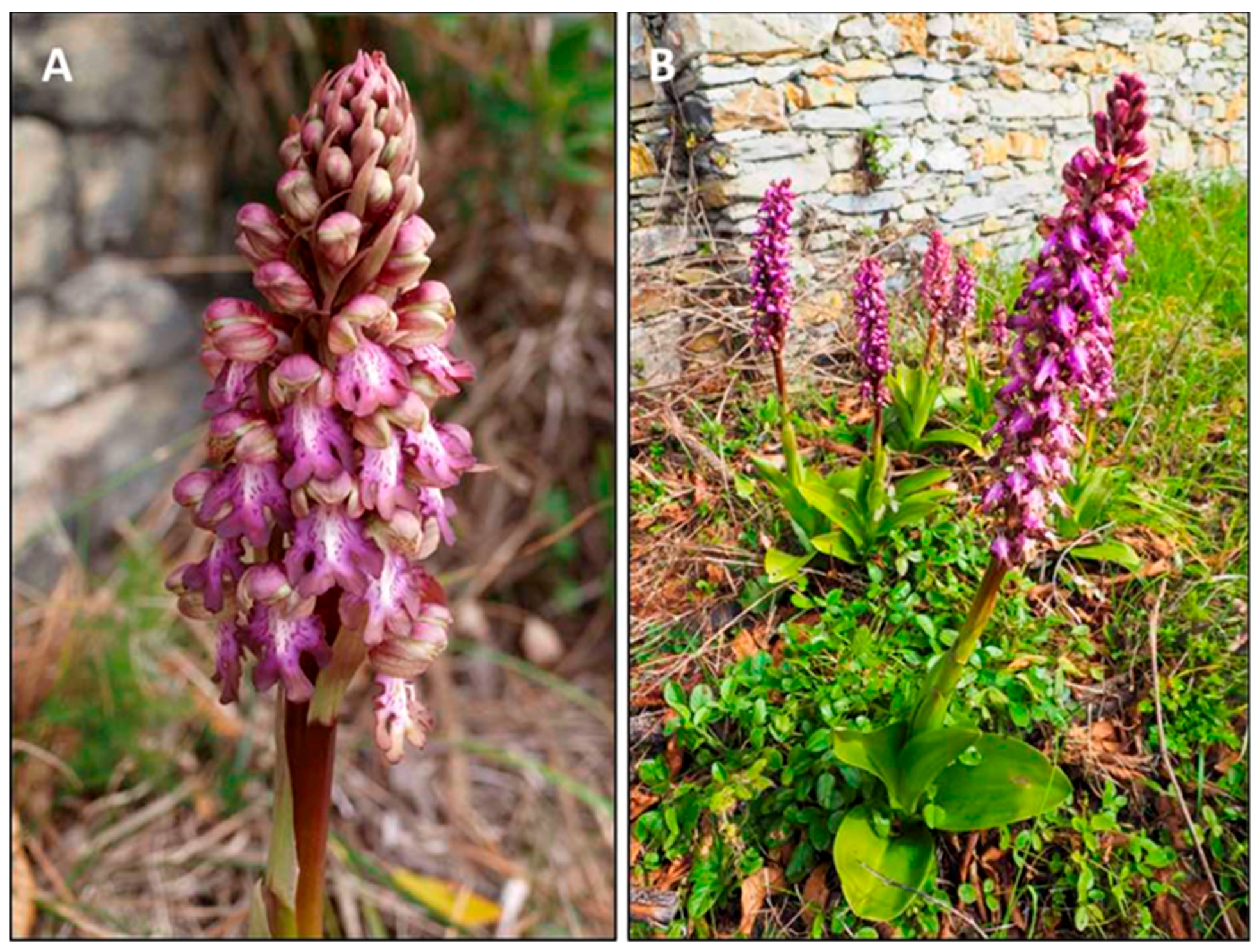
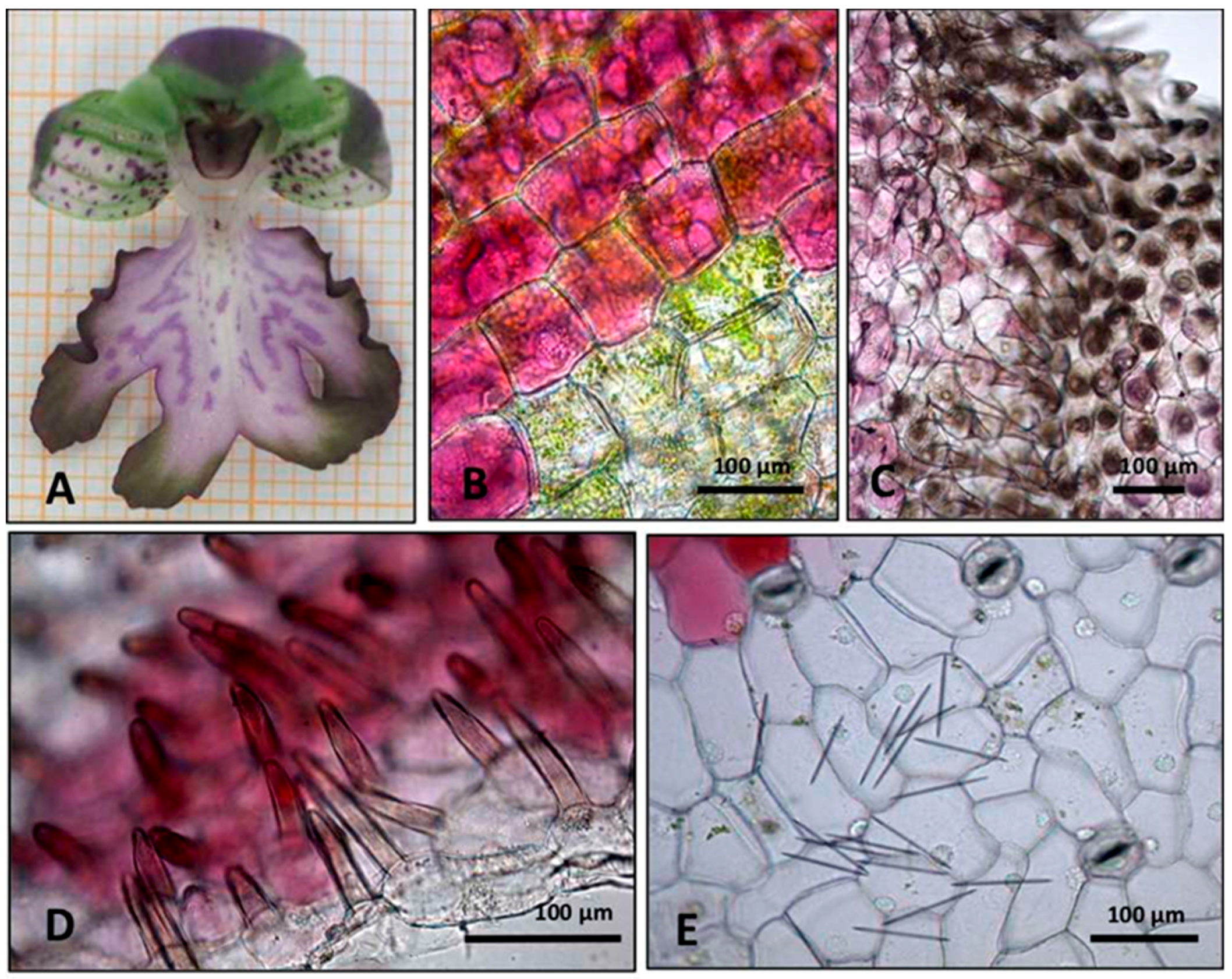
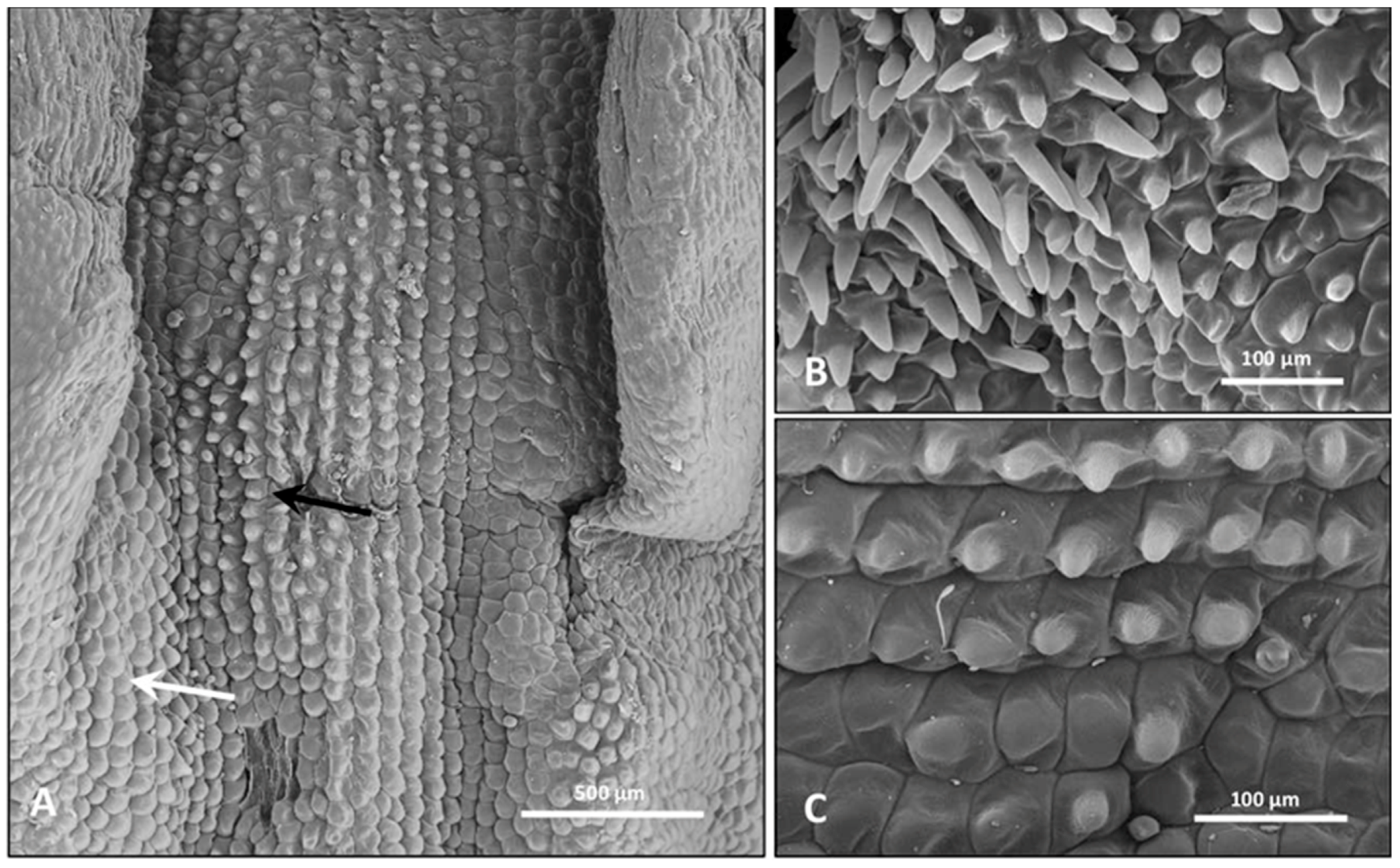
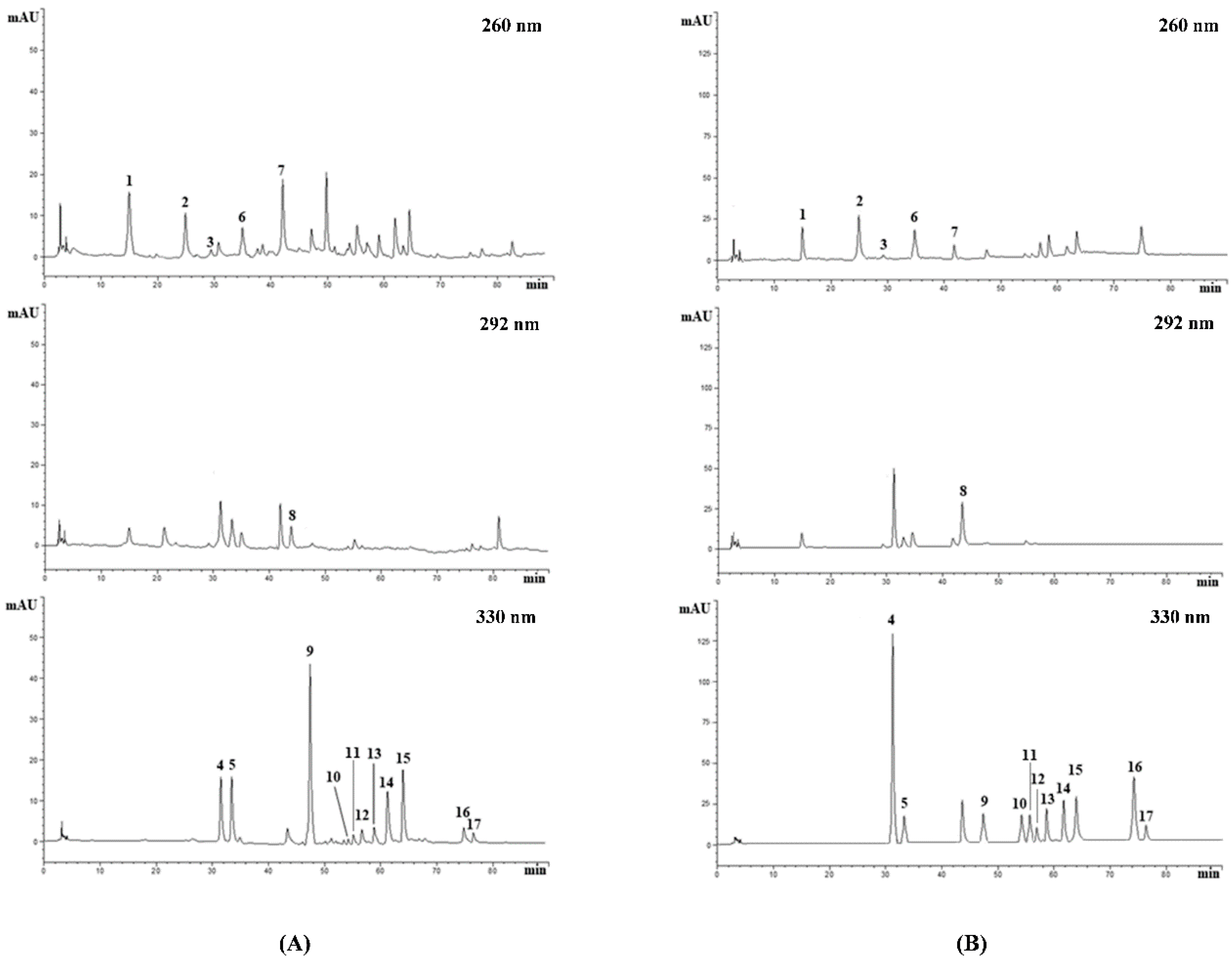
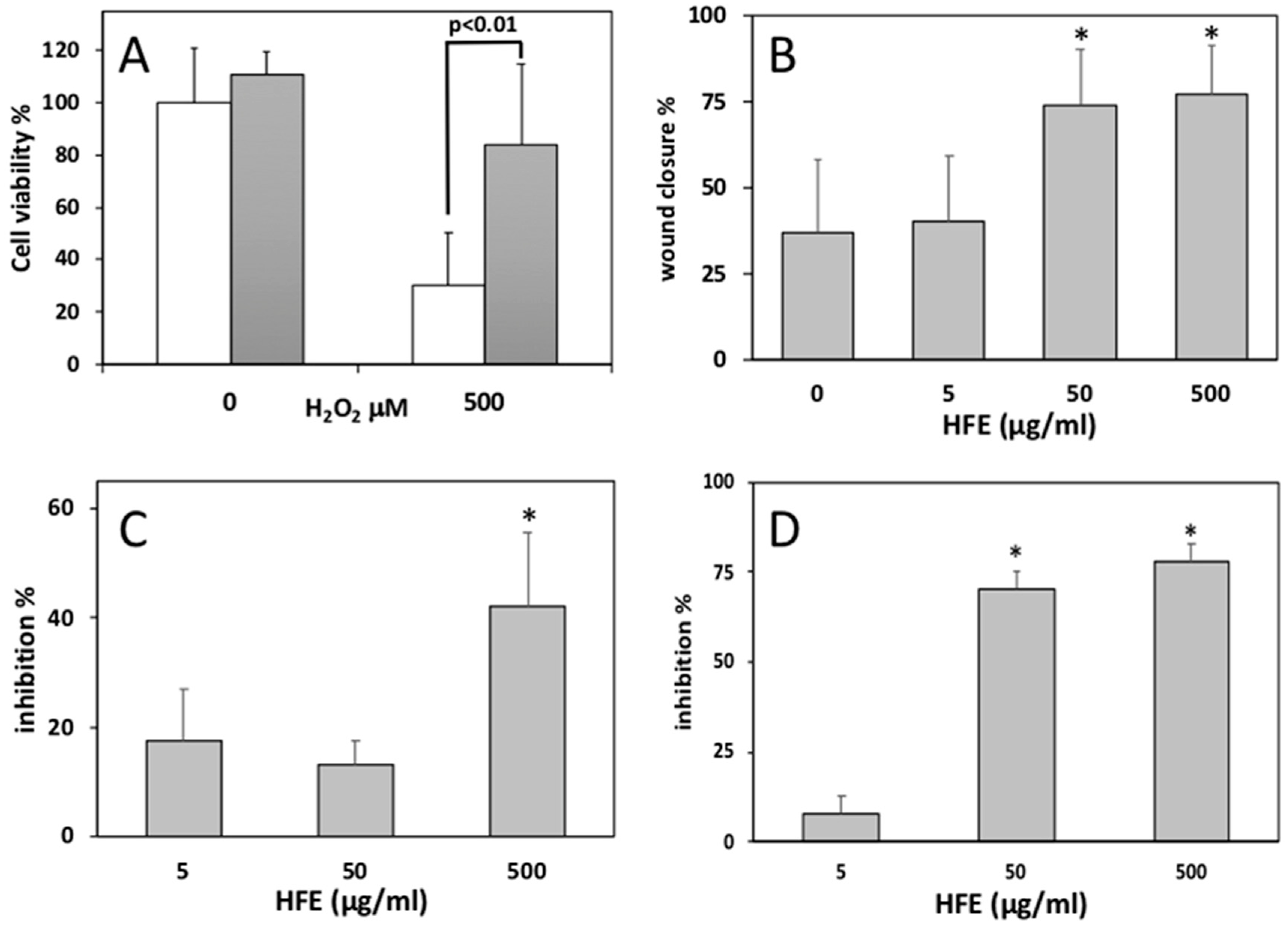
| Phytochemical Screening | HFE |
|---|---|
| Total phenols (mg GAE 1/100 g FW) | 243.7 ± 26.2 |
| Flavonoids (mg QuE 2/100 g FW) | 398.1 ± 9.8 |
| Anthocyanins (mg ChE 3/100 g FW) | 4.89 ± 0.05 |
| Proanthocyanidins (mg CyE 4/100 g FW) | 0.05 ± 0.001 |
| Vanillin index (mg CatE 5/100 gFW) | 3.31 ± 0.03 6 |
| Polymerization index | 66.2 |
| Peak n. 1 | Compound | Rt 2 (min) | λmax (nm) | mg/100 g FW 3 |
|---|---|---|---|---|
| Phenolic acids | ||||
| 1 | Protocatecuic acid | 15.057 | 260; 294 | 7.8 ± 0.06 |
| 2 | Hydroxybenzoic acid | 25.543 | 255 | 0.09 ± 0.001 |
| 4 | Chlorogenic acid | 31.399 | 294; 326 | 10.85 ± 0.44 |
| 5 | Caffeic acid | 33.614 | 232; 323 | 11.52 ± 0.37 |
| 6 | Vanillic acid | 35.252 | 260; 292 | 0.08 ± 0.002 |
| 8 | Coumaric acid | 43.811 | 233; 310 | 3.33 ± 0.02 |
| Flavan-3-ols | ||||
| 3 | Catechin | 29.451 | 234; 279 | 2.63 ± 0.02 |
| 7 | Epicatechin | 42.062 | 232; 280 | 9.87 ± 0.38 |
| Flavones | ||||
| 10 | Isovitexin | 55.300 | 270; 337 | 3.82 ± 0.04 |
| 11 | Naringenin-7-O-glucoside | 55.878 | 284; 340 | 0.98 ± 0.02 |
| 12 | Vitexin | 57.145 | 268; 338 | 5.47 ± 0.05 |
| 13 | Rutin | 59.281 | 256; 356 | 5.08 ± 0.03 |
| 14 | Kaempferol-3-O-rutinoside | 61.975 | 266; 348 | 21.1 ± 0.25 |
| 15 | Roifolin | 64.619 | 266; 338 | 9.23 ± 0.08 |
| 16 | Luteolin | 74.693 | 254; 350 | 0.86 ± 0.04 |
| 17 | Apigenin | 76.417 | 236; 338 | 3.01 ± 0.07 |
| Coumarins | ||||
| 9 | Scopoletin | 47.373 | 296; 344 | 48.85 ± 0.48 |
| Antioxidant Assay | HFE |
|---|---|
| IC50 1 μg/mL (95% C.L. 2) | |
| DPPH | 211.1 (181.1–245.3) 3 |
| FRAP | 8.85 (7.69–10.18) |
| TEAC | 25.04 (20.41–30.71) |
| ORAC | 2.52 (2.19–2.9) |
| β-carotene bleaching | 31.43 (22.12–44.66) |
| Iron-chelating activity | 440.8 (330.1–588.6) |
| Peak n. 1 | Compound | Rt (min) | λmax (nm) | Regression Coefficient (R2) |
|---|---|---|---|---|
| 1 | Protocatecuic acid | 15.055 | 260; 294 | 0.9999 |
| 2 | Hydroxybenzoic acid | 25.545 | 255 | 0.9997 |
| 3 | Catechin | 29.453 | 234; 279 | 0.9997 |
| 4 | Chlorogenic acid | 31.401 | 294; 326 | 0.9999 |
| 5 | Caffeic acid | 33.617 | 232; 323 | 0.9998 |
| 6 | Vanillic acid | 35.254 | 260; 292 | 0.9996 |
| 7 | Epicatechin | 42.065 | 232; 280 | 0.9999 |
| 8 | Coumaric acid | 43.813 | 233; 310 | 0.9999 |
| 9 | Scopoletin | 47.375 | 296; 344 | 0.9999 |
| 10 | Isovitexin | 55.302 | 270; 337 | 0.9997 |
| 11 | Naringenin-7-O-glucoside | 55.881 | 284; 340 | 0.9998 |
| 12 | Vitexin | 57.145 | 268; 338 | 0.9996 |
| 13 | Rutin | 59.282 | 256; 356 | 0.9997 |
| 14 | Kaempferol-3-O-rutinoside | 61.977 | 266; 348 | 0.9998 |
| 15 | Roifolin | 64.620 | 266; 338 | 0.9999 |
| 16 | Luteolin | 74.695 | 254; 350 | 0.9999 |
| 17 | Apigenin | 76.418 | 236; 338 | 0.9998 |
© 2019 by the authors. Licensee MDPI, Basel, Switzerland. This article is an open access article distributed under the terms and conditions of the Creative Commons Attribution (CC BY) license (http://creativecommons.org/licenses/by/4.0/).
Share and Cite
Bazzicalupo, M.; Burlando, B.; Denaro, M.; Barreca, D.; Trombetta, D.; Smeriglio, A.; Cornara, L. Polyphenol Characterization and Skin-Preserving Properties of Hydroalcoholic Flower Extract from Himantoglossum robertianum (Orchidaceae). Plants 2019, 8, 502. https://doi.org/10.3390/plants8110502
Bazzicalupo M, Burlando B, Denaro M, Barreca D, Trombetta D, Smeriglio A, Cornara L. Polyphenol Characterization and Skin-Preserving Properties of Hydroalcoholic Flower Extract from Himantoglossum robertianum (Orchidaceae). Plants. 2019; 8(11):502. https://doi.org/10.3390/plants8110502
Chicago/Turabian StyleBazzicalupo, Miriam, Bruno Burlando, Marcella Denaro, Davide Barreca, Domenico Trombetta, Antonella Smeriglio, and Laura Cornara. 2019. "Polyphenol Characterization and Skin-Preserving Properties of Hydroalcoholic Flower Extract from Himantoglossum robertianum (Orchidaceae)" Plants 8, no. 11: 502. https://doi.org/10.3390/plants8110502
APA StyleBazzicalupo, M., Burlando, B., Denaro, M., Barreca, D., Trombetta, D., Smeriglio, A., & Cornara, L. (2019). Polyphenol Characterization and Skin-Preserving Properties of Hydroalcoholic Flower Extract from Himantoglossum robertianum (Orchidaceae). Plants, 8(11), 502. https://doi.org/10.3390/plants8110502








